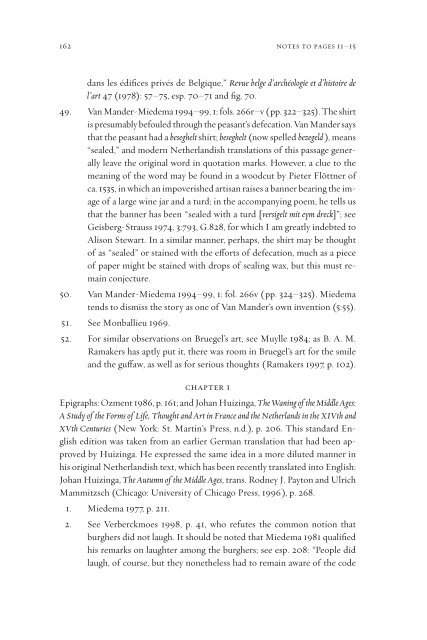Pieter Bruegel and the Art of Laughter - AAAARG.ORG
Pieter Bruegel and the Art of Laughter - AAAARG.ORG
Pieter Bruegel and the Art of Laughter - AAAARG.ORG
You also want an ePaper? Increase the reach of your titles
YUMPU automatically turns print PDFs into web optimized ePapers that Google loves.
162 notes to pages 11–15<br />
dans les édifices privés de Belgique,” Revue belge d’archéologie et d’histoire de<br />
l’art 47 (1978): 57–75, esp. 70–71 <strong>and</strong> fig. 70.<br />
49. Van M<strong>and</strong>er-Miedema 1994–99, 1: fols. 266r–v (pp. 322–325). The shirt<br />
is presumably befouled through <strong>the</strong> peasant’s defecation. Van M<strong>and</strong>er says<br />
that <strong>the</strong> peasant had a beseghelt shirt; beseghelt (now spelled bezegeld ), means<br />
“sealed,” <strong>and</strong> modern Ne<strong>the</strong>rl<strong>and</strong>ish translations <strong>of</strong> this passage generally<br />
leave <strong>the</strong> original word in quotation marks. However, a clue to <strong>the</strong><br />
meaning <strong>of</strong> <strong>the</strong> word may be found in a woodcut by <strong>Pieter</strong> Flöttner <strong>of</strong><br />
ca. 1535, in which an impoverished artisan raises a banner bearing <strong>the</strong> image<br />
<strong>of</strong> a large wine jar <strong>and</strong> a turd; in <strong>the</strong> accompanying poem, he tells us<br />
that <strong>the</strong> banner has been “sealed with a turd [versigelt mit eym dreck]”; see<br />
Geisberg-Strauss 1974, 3:793, G.828, for which I am greatly indebted to<br />
Alison Stewart. In a similar manner, perhaps, <strong>the</strong> shirt may be thought<br />
<strong>of</strong> as “sealed” or stained with <strong>the</strong> eªorts <strong>of</strong> defecation, much as a piece<br />
<strong>of</strong> paper might be stained with drops <strong>of</strong> sealing wax, but this must remain<br />
conjecture.<br />
50. Van M<strong>and</strong>er-Miedema 1994–99, 1: fol. 266v ( pp. 324–325). Miedema<br />
tends to dismiss <strong>the</strong> story as one <strong>of</strong> Van M<strong>and</strong>er’s own invention (5:55).<br />
51. See Monballieu 1969.<br />
52. For similar observations on <strong>Bruegel</strong>’s art, see Muylle 1984; as B. A. M.<br />
Ramakers has aptly put it, <strong>the</strong>re was room in <strong>Bruegel</strong>’s art for <strong>the</strong> smile<br />
<strong>and</strong> <strong>the</strong> guªaw, as well as for serious thoughts (Ramakers 1997, p. 102).<br />
chapter 1<br />
Epigraphs: Ozment 1986, p. 161; <strong>and</strong> Johan Huizinga, The Waning <strong>of</strong> <strong>the</strong> Middle Ages:<br />
A Study <strong>of</strong> <strong>the</strong> Forms <strong>of</strong> Life, Thought <strong>and</strong> <strong>Art</strong> in France <strong>and</strong> <strong>the</strong> Ne<strong>the</strong>rl<strong>and</strong>s in <strong>the</strong> XIVth <strong>and</strong><br />
XVth Centuries (New York: St. Martin’s Press, n.d.), p. 206. This st<strong>and</strong>ard English<br />
edition was taken from an earlier German translation that had been approved<br />
by Huizinga. He expressed <strong>the</strong> same idea in a more diluted manner in<br />
his original Ne<strong>the</strong>rl<strong>and</strong>ish text, which has been recently translated into English:<br />
Johan Huizinga, The Autumn <strong>of</strong> <strong>the</strong> Middle Ages, trans. Rodney J. Payton <strong>and</strong> Ulrich<br />
Mammitzsch (Chicago: University <strong>of</strong> Chicago Press, 1996 ), p. 268.<br />
1. Miedema 1977, p. 211.<br />
2. See Verberckmoes 1998, p. 41, who refutes <strong>the</strong> common notion that<br />
burghers did not laugh. It should be noted that Miedema 1981 qualified<br />
his remarks on laughter among <strong>the</strong> burghers; see esp. 208: “People did<br />
laugh, <strong>of</strong> course, but <strong>the</strong>y none<strong>the</strong>less had to remain aware <strong>of</strong> <strong>the</strong> code












